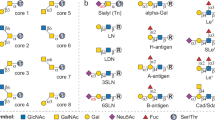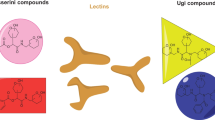Abstract
The transformation from normal to malignant phenotype in human cancers is associated with aberrant cell-surface glycosylation. Thus, targeting glycosylation changes in cancer is likely to provide not only better insight into the roles of carbohydrates in biological systems, but also facilitate the development of new molecular probes for bioanalytical and biomedical applications. In the reported study, we have synthesized lectinomimics based on odorranalectin 1; the smallest lectin-like cyclic peptide isolated from the frog Odorrana grahami skin, and assessed the ability of these peptides to bind specific carbohydrates on molecular and cellular levels. In addition, we have shown that the disulfide bond found in 1 can be replaced with a lactam bridge. However, the orientation of the lactam bridge, peptides 2 and 3, influenced cyclic peptide‘s conformation and thus these peptides’ ability to bind carbohydrates. Naturally occurring 1 and its analog 3 that adopt similar conformation in water bind preferentially l-fucose, and to a lesser degree d-galactose and N-acetyl-d-galactosamine, typically found within the mucin O-glycan core structures. In cell-based assays, peptides 1 and 3 showed a similar binding profile to Aleuria aurantia lectin and these two peptides inhibited the migration of metastatic breast cancer cell lines in a Transwell assay. Altogether, the reported data demonstrate the feasibility of designing lectinomimics based on cyclic peptides.











Similar content being viewed by others
Abbreviations
- RMSD:
-
Root-mean-square deviation
- AAL:
-
Aleuria aurantia lectin
- ASF:
-
Asialofetuin
- BME:
-
β-Mercaptoethanol
- Boc:
-
Tert-butyloxycarbonyl
- BSA:
-
Bovine serum albumin
- CM:
-
Conditioned medium
- CV:
-
Coefficient of variation
- DIC:
-
Diisopropylcarbodiimide
- DMF:
-
N,N-Dimethylformamide
- DMSO:
-
Dimethyl sulfoxide
- FAM:
-
Fluorescein
- FITC:
-
Fluorescein isothiocyanate
- Fmoc:
-
Fluorenylmethyloxycarbonyl
- HOBt:
-
Hydroxybenzotriazole
- ITC:
-
Isothermal titration calorimetry
- MALDI–TOF:
-
Matrix assisted laser desorption/ionization time-of-flight
- NMM:
-
N-Methylmorpholine
- PyBOP:
-
Benzotriazol-1-yl-oxytripyrrolidinophosphonium hexafluorophosphate
- RP-HPLC:
-
Reverse-phase high pressure liquid chromatography
- RT:
-
Room temperature
- S/B:
-
Signal-to-background
- SNA:
-
Sambucus nigra lectin
- UEA-I:
-
Ulex europaeus I lectin
- SPPS:
-
Solid-phase peptide synthesis
- TFA:
-
Trifluoroacetic acid, UV–Vis, ultraviolet–visible
References
Alsina J, Rabanal F, Giralt E, Albericio F (1994) Solid-phase synthesis of “head-to-tail” cyclic peptides via lysine side-chain anchoring. Tetrahedron Lett 35(51):9633–9635
Ambrosi M, Cameron NR, Davis BG (2005) Lectins: tools for the molecular understanding of the glycocode. Org Biomol Chem 3(9):1593–1608
Baldus SE, Thiele J, Park Y-O, Hanishi F-G, Bara J, Fischer R (1996) Characterization of the binding specificity of Anguilla anguilla agglutinin (AAA) in comparison to Ulex europaeus agglutinin I (UEA-I). Glyconj J 13(4):585–590
Brannon JR, Thomassin JL, Gruenheid S, Le Moual H (2015) Antimicrobial peptide conformation as a structural determinant of omptin protease specificity. J Bacteriol 197(22):3583–3591. doi:10.1128/JB.00469-15 (pii:JB.00469-15)
Cazet A, Julien S, Bobowski M, Burchell J, Delannoy P (2010) Tumour-associated carbohydrate antigens in breast cancer. Breast Cancer Res 12(3):204–217
Cline LL, Waters ML (2009) The structure of well-folded beta-hairpin peptides promotes resistance to peptidase degradation. Biopolymers 92(6):502–507. doi:10.1002/bip.21266
Dall’Olio F, Malagolini N, Chiricolo M (2012) Glycosylation in cancer. Carbohydr Chem 37:21–56
Dalziel M, Crispin M, Scanlan CN, Zitzmann N, Dwek RA (2014) Emerging principles for the therapeutic exploitation of glycosylation. Science 343(6166):1235681
Dennington R, Keith T, Millam J (2009) Gauss View, version 5, Semichem Inc., Shawnee Mission
Drake RR (2015) Glycosylation and cancer: moving glycomics to the forefront. Adv Cancer Res 126:1–10
Fazio MA, Oliveira VX, Bulet P, Miranda MTM, Daffre S, Miranda A (2006) Structure-activity relationship studies of gomesin: importance of the disulfide bridges for conformation, bioactivities, and serum stability. Biopolymers 84(2):205–218
Feng D, Shaikh AS, Wang F (2016) Recent advance in tumor-associated carbohydrate antigens (TACAs)-based antitumor vaccines. ACS Chem Biol 11(4):850–863
Fiedler W, DeDosso S, Cresta S, Weidmann J, Tessari A, Salzberg M, Dietrich B, Baumeister H, Goletz S, Gianni L, Sessa C (2016) A phase I study of PankoMab-GEX, a humanised glyco-optimised monoclonal antibody to a novel tumour-specific MUC1 glycopeptide epitope in patients with advanced carcinomas. Eur J Cancer 63:55–63
Fischer R, Mader O, Jung G, Brock R (2003) Extending the applicability of carboxyfluorescein in solid-phase synthesis. Bioconjugate Chem 14(3):653–660
Flora D, Mo H, Mayer JP, Khan MA, Yan LZ (2005) Detection and control of aspartimide formation in the synthesis of cyclic peptides. Bioorg Med Chem Lett 15:1065–1068
Frisch M, Trucks G, Schlegel H, Scuseria G, Robb M, Cheeseman J, Scalmani G, Barone V, Mennucci B, Petersson G (2009) Gaussian 09. Gaussian Inc, Wallingford, p 4
Fuster MM, Esko JD (2005) The sweet and sour of cancer: glycans as novel therapeutic targets. Nat Rev Cancer 5(7):526–542
Gazal S, Gelerman G, Ziv O, Karpov O, Litman P, Bracha M, Afargan M, Gilon C (2002) Human somatostatin receptor specificity of backbone-cyclic analogues containing novel sulfur building units. J Med Chem 45(8):1665–1671
Gomez-Martinez P, Dessolin M, Guibe F, Albericio F (1999) N α-Alloc temporary protection in solid-phase peptide synthesis. The use of amine-borane complexes as allyl group scavengers. J Chem Soc Perkin Trans 1(20):2871–2874
Gongora-Benitez M, Tulla-Puche J, Albericio F (2014) Multifaceted roles of disulfide bonds. Peptides as Therapeutics. Chem Rev 114(2):901–926
Green ED, Adelt G, Baenziger JU, Wilson S, Van Halbeek H (1988) The asparagine-linked oligosaccharides on bovine fetuin. Structural analysis of N-glycanase-released oligosaccharides by 500-megahertz proton NMR spectroscopy. J Biol Chem 263(34):18253–18268
Hakomori SI, Cummings RD (2012) Glycosylation effects on cancer development. Glycoconj J 29(8–9):565–566
Hakomori S, Kannagi R (1983) Glycosphingolipids as tumor-associated and differentiation markers. J Natl Cancer Inst 71:231–251
Hargittai B, Sole´ NA, Groebe DR, Abramson SN, Barany G (2000) Chemical syntheses and biological activites of lactam analogues of α-conotoxin SI. J Med Chem 43(25):4787–4792
Häuselmann I, Borsig L (2014) Altered tumor-cell glycosylation promotes metastasis. Front Oncol 4(28):1–15
Hossain K, Wall KA (2016) Immunological evaluation of recent MUC1 glycopeptide cancer vaccines. Vaccines 4(3):E25
Jessani N, Niessen S, Mueller BM, Cravatt BF (2005) Breast cancer cell lines grown in vivo: what goes in isn’t always the same as what comes out. Cell Cycle 4(2):253–255
Kamber B, Hartmenn A, Eisler K, Riniker B, Rink H, Siber P, Rittel W (1980) The synthesis of cystein peptides by iodine oxidation of S-trytil-cysteine and S-acetamidomethyl-cysteine peptides. Helv Chim Acta 63:899–915
Li P, Roller PP, Xu J (2002) Current synthetic approaches to peptide and peptidomimetic cyclization. Curr Org Chem 6(5):411–440
Li J, Wu H, Hong J, Xu X, Yang H, Wu B, Wang Y, Zhu J, Lai R, Jiang X, Lin D, Prescott MC, Rees HH (2008) Odorranalectin is a small peptide lectin with potential for drug delivery and targeting. PLoS ONE 3(6):2381–2391
Liskamp RMJ, Rijkers DTS, Kruijtzer JAW, Kemmick J (2011) Peptides and proteins as a continuing exciting source of inspiration for peptidomimetics. ChemBioChem 12(11):1626–1653
Loffet A (2002) Peptides as drugs: is there a market? J Pept Sci 8:1–7
Loureiro LR, Carrascal MA, Barbas A, Ramalho JS, Novo C, Delannoy P, Videira P (2015) Challenges in antibody development against Tn and Sialyl-Tn antigens. Biomolecules 5(3):1783–1809
McDonald DM, Byrne SN, Payne RJ (2015) Synthetic self-adjuvanting glycopeptide cancer vaccines. Front Chem 3(60):1–8
Meinander K, Pakkala M, Weisell J, Stenman UH, Koistinen H, Narvanen A, Wallen EAA (2014) Replacement of the disulfide bridge in a KLK3-stimulating peptide using orthogonally protected building blocks. ACS Med Chem Lett 5(2):162–165
Meng EC, Pettersen EF, Couch GS, Huang CC, Ferrin TE (2006) Tools for integrated sequence-structure analysis with UCSF Chimera. BMC Bioinform 7(1):1
Miyoshi E, Moriwaki K, Terao N, Tan C-C, Terao M, Nakagawa T, Matsumoto H, Shinzaki S, Kamada Y (2012) Fucosylation is a promising target for cancer diagnosis and therapy. Biomolecules 2(1):34–45
Morris GM, Huey R, Lindstrom W, Sanner MF, Belew RK, Goodsell DS, Olson AJ (2009) AutoDock4 and AutoDockTools4: automated docking with selective receptor flexibility. J Comp Chem 30(16):2785–2791
Muller S, Hanisch F-G (2002) Recombinant MUC1 probe authentically reflects cell-specific O-glycosylation profiles of endogenous breast cancer mucin: high density andd prevalent core 2-based glycosylation. J Biol Chem 277:26103–26112
Munkley J, Elliott DJ (2016) Hallmarks of glycosylation in cancer. Oncotarget 7(23):35478–35489
Nath S, Mukherjee P (2014) MUC1: a multifaceted oncoprotein with a key role in cancer progression. Trends Mol Med 20(6):332–342
Pinho SS, Reis CA (2015) Glycosylation in cancer: mechanisms and clinical implications. Nat Rev Cancer 15:540–555
Pipkorn R, Rawer S, Wiessler M, Waldek W, Koch M, Schrenk H, Braun K (2013) SPPS resins impact the PNA-syntheses’ improvement. Int J Med Sci 10:331–337
Samsonov SA, Teyra J, Pisabarro MT (2011) Docking glycosaminoglycans to proteins: analysis of solvent inclusion. J Comput Aided Mol Des 25(5):477–489
Shibuya N, Goldstein I, Broekaert W, Nsimba-Lubaki M, Peeters B, Peumans W (1987) The elderberry (Sambucus nigra L.) bark lectin recognizes the Neu5Ac(alpha 2-6)Gal/GalNAc sequence. J Biol Chem 262:1596–1601
Song X, Heimburg-Molinaro J, Smith DF, Cummings RD (2012) Glycan microarrays. Methods Mol Biol 800:163–171
Spiro R, Bhoyroo V (1974) Structure of the O-glycosidically linked carbohydrate units of fetuin. J Biol Chem 249:5704–5717
Sterner E, Flanagan N, Gildersleeve JC (2016) Perspectives on anti-glycan antibodies gleaned from development of a community resource database. ACS Chem Biol 11(7):1773–1783
Stowell SR, Ju T, Cummings RD (2015) Protein glycosylation in cancer. Annu Rev Pathol 10:473–510
Subiros-Funosas R, El-Faham A, Albericio F (2011) Aspartimide formation in peptide chemistry: ocurrence, prevention strategies and the role of N-hydroxylamines. Tetrahedron 67:8595–8606
Tang H, Hsueh P, Kletter D, Bern M, Haab B (2015) The detection and discovery of glycan motifs in biological samples using lectins and antibodies: new methods and opportunities. Adv Cancer Res 126:167–202
Veronese FM, Mero A (2008) The impact of PEGylation on biological therapies. BioDrugs 22(5):315–329
Wimmerova M, Mitchell E, Sanchez J-F, Gautier C, Imberty A (2003) Crystal structure of fungal lectins: six-bladed beta-propeller fold and novel fucose recognition mode for Aleuria aurantia lectin. J Biol Chem 278:27059–27067
Yuan K, Kucik D, Sigh RK, Listinsky CM, Listinsky JL, Siegal GP (2008) Alterations in human breast cancer adhesion-motility in response to changes in cell surface glycoproteins α-l-fucose moieties. Int J Oncol 32(4):797–807
Zhang HB, Chi YS, Huang WL, Ni SJ (2007) Total synthesis of human urotensin-II by microwave-assisted solid phase method. Chin Chem Lett 18:902–904
Zhao Y-J, Ju Q, Li G-C (2013) Tumor markers for hepatocellular carcinoma. Mol Clin Oncol 1(4):593–598
Acknowledgements
We thank Dr. Anna Knapinska for providing tissue-culture expertise and Ms. Karen Gottwald for editing of the manuscript. This work was partly supported by the Florida Atlantic University [start-up funds to M.C.]; and the National Institutes of Health [National Institute on Drug Abuse (NIDA) RDA039722A to P.C. and National Cancer Institute (NCI) CA178754 to M.C.]. K.M.M. thanks Instituto de Química, UNAM for financing support.
Author information
Authors and Affiliations
Corresponding authors
Ethics declarations
Conflict of interest
The authors declare that they have no conflicts of interest with the contents of this article.
Research involving human participants and/or animals
This article does not contain any studies with human participants or animals performed by any other authors.
Additional information
Handling Editor: F. Albericio.
Electronic supplementary material
Below is the link to the electronic supplementary material.
Rights and permissions
About this article
Cite this article
Rodriguez, M.C., Yongye, A.B., Cudic, M. et al. Targeting cancer-specific glycans by cyclic peptide lectinomimics. Amino Acids 49, 1867–1883 (2017). https://doi.org/10.1007/s00726-017-2485-3
Received:
Accepted:
Published:
Issue Date:
DOI: https://doi.org/10.1007/s00726-017-2485-3




